- A-11 ,Shop no 22 ,Main Opera Road, Indra Vihar, Kota


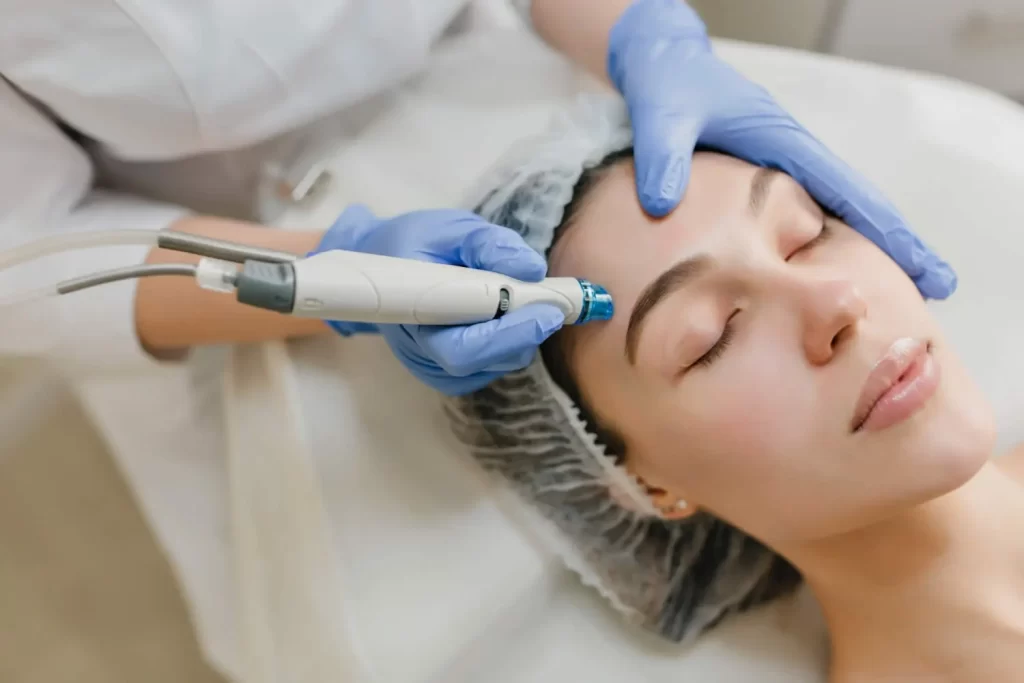
Dermabrasion is an exfoliating technique that uses a rotating instrument to remove the outer layers of skin, usually on the face. This treatment is popular with people who wish to improve the appearance of their skin.
Dermabrasion is a type of surgical skin planing, typically performed in a professional medical setting by a dermatologist or plastic surgeon trained specifically in this procedure. Dermabrasion has been practiced for many years (before the advent of lasers) and involves the controlled deeper abrasion (wearing away) of the upper to mid-layers of the skin with any variety of strong abrasive devices including a wire brush, diamond wheel or fraise, sterilized sandpaper, salt crystals, or other mechanical means. Dermabrasion should not be confused with microdermabrasion which is a newer and non-surgical cosmetic procedure performed by non-physician personnel, nurses, estheticians, medical assistants.
Dermabrasion removes damaged outer layers of skin. This exposes new layers of skin that appear younger and smoother.
In addition to providing a more youthful appearance, dermabrasion can also help treat:
Acne scars.
Age spots.
Fine wrinkles.
precancerous skin patches.
Rhinophyma, or redness and thick skin on the nose.
Scars from surgery or injury.
Sun damage.
Uneven skin tone.
Dermabrasion is only one of many treatments for these conditions. For instance, advances in laser technology make laser tattoo removal quicker and easier. Talk to your dermatologist about all of the treatment options for your specific condition.
Some skin conditions may prevent your doctor from performing dermabrasion, including inflammatory acne, recurrent herpes flare-ups, radiation burns, or burn scars.
You may also be unable to receive dermabrasion if you’ve taken medications with a skin-thinning side effect. And your doctor may not recommend dermabrasion if your skin tone is naturally very dark.
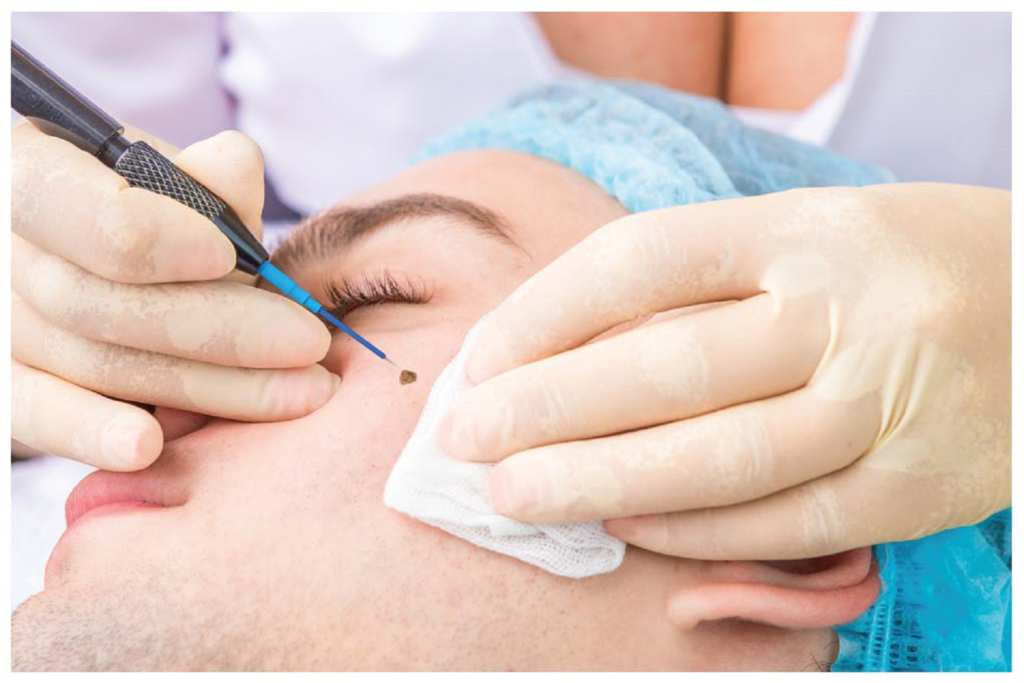
Electrocautery, also known as thermal cautery, refers to a process in which a direct or alternating current is passed through a resistant metal wire electrode, generating heat. The heated electrode is then applied to living tissue to achieve hemostasis or varying degrees of tissue destruction. Electrocautery can be used in various minor surgical procedures in dermatology, ophthalmology, otolaryngology, plastic surgery, and urology.
Electrocautery is a safe and effective method of hemostasis during cutaneous surgery. It is also useful in the treatment of various small benign skin lesions, although only lesions that do not require histological review should be treated with electrocautery.
Electrocautery shares many indications with electrosurgery and is of particular importance in patients who have implanted electrical devices in whom external electromagnetic interference should be avoided. Furthermore, unlike electrosurgical instruments, electrocautery devices maintain function in a wet field.
Low temperatures can be used for superficial tissue destruction in the treatment of superficial and relatively avascular lesions, including the following:
There is a risk of fire or explosion if flammable materials are in close proximity to the treatment site.
Alcohol, oxygen and bowel gas are all highly flammable. Alcohol cleansers should be avoided; if they are used, they should be allowed to dry completely. If the patient uses a portable oxygen generator, it should be stopped briefly for the procedure. Eschar buildup should be removed from the surgical electrode to avoid sparking or flaming.
The same principles of infection transmission apply to both electrosurgery and electrocautery. The 3 potential modes for infection transmission in these procedures include the treatment electrode, surgical smoke and aerosolized blood microdroplets. Experimental studies involving animal skin have shown transmission of hepatitis B virus, human papillomavirus (HPV) and Staphylococcus aureus from an inoculated site to an uninfected site by means of the contaminated electrodesiccation electrode.
During electrosurgical procedures, aerosolized blood droplets can be propelled a distance of up to 30 cm and can be infectious if inhaled. Surgical smoke can also contain viable viruses and bacteria, in addition to hazardous chemicals and carcinogens. The viable HPV virus has been identified in the vapor of warts being treated with electrocoagulation.
To prevent the risks of infection transmission, a smoke-evacuating system should be used, along with facial masks, protective eyewear and surgical gloves. Disposable or sterilized electrodes should be used.
Electrocautery is a safe and effective method of treatment for benign cutaneous lesions and hemostasis for surgical patients.
Studies have also shown that thermal cautery occlusion in vasectomies is more effective than clipping and excision of a segment of the vas.
Furthermore, surgical lacrimal punctual occlusion for dry eyes using a thermal cautery device is associated with low recanalization rates, higher visual acuity and overall greater subjective improvement in symptoms.
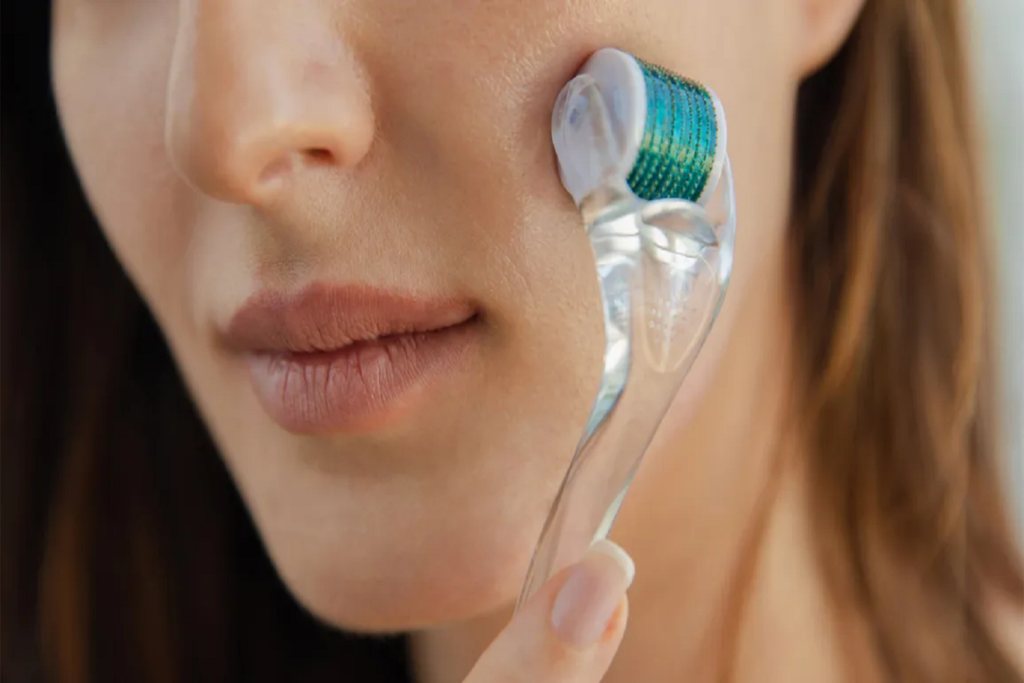
Micro-needling is a general term for a process that involves moving a special device over your skin that has a roller with many tiny (usually metal) needles embedded in it. There are different kinds of micro-needling devices with different product names. There are also motorized devices such as the Dermapen. For the most part, these micro-needling devices have reasonable science behind them indicating they may help in reducing the appearance of scars, but there’s far less support for their ability to address wrinkles or for their ability to help anti-aging ingredients absorb better into the skin.
Dermapens looks exactly like a pen, with a circular head studded with tiny needles. The head and needles are motorized. The motor-driven needles move in and out of the skin in a stamping motion, piercing it with thousands of tiny punctures.
There are three primary uses for micro-needling devices, but not all of them are beneficial. The first, which has some good research behind it, is to break down the thick collagen that causes some types of scarring.
You may have seen claims that these needling procedures can also reduce cellulite. However, whether or not micro-needling of any kind can work on cellulite is at best dubious. That’s because cellulite involves fat deposits in the connective tissue on the legs and buttocks and needling skin cannot change any of this, not even a little. If you see results on your cellulite from needling, it’s most likely due to the inflammation from the needles, not because cellulite was reduced.
Once the inflammation subsides, the cellulite looks just like it did before needling. So the needling can help, but just a little and the results will be temporary. In terms of building collagen, the Dermapen and Dermastamp have emerging research about their benefits for wrinkles as an easy procedure that’s far less expensive than other devices or treatments. In contrast, the Dermaroller has no such research, though again, theoretically there’s logic to the concept.
Microneedling or micro-needling is a process that involves using needles to puncture hundreds of tiny holes in the skin (yes, seriously).
It may seem like the newest trend in beauty skincare, but it’s actually been around and evolving for over 50 years!
Fans of the microneedle claim it treats everything from wrinkles, hyperpigmentation and dull skin to issues such as scars, stretch marks, and cellulite -although results are still dubious on that last one, so don’t get your hopes up.

Skin tightening is the anti-aging treatment which is used for wrinkle reduction, fat reduction, loose skin and the alleviation of other signs of aging. Machines that are used for skin tightening are Thermage and Lasers.Laser skin tightening is a minimally invasive, non-surgical process that uses an infrared light source (a laser) to tighten skin by heating the collagen under the skin’s surface, causing the skin to contract (tighten). Facial skin tightening is noticeable immediately after the treatment and there is no downtime, making this an increasingly popular procedure. Additional skin tightening occurs over the next few months, but optimal results usually require two or three treatments about a month apart. Laser skin tightening is an FDA approved method for the reduction of fine lines, wrinkles and skin laxity. While laser skin tightening results may not be as dramatic as those of a facelift, patients enjoy moderate results with no downtime. An added benefit of laser skin tightening is that it is safe and effective for restoring a more firm, youthful appearance to skin all over the body.
Thermage is a safe, non-invasive, radiofrequency (RF) cosmetic procedure that’s clinically proven to help smooth and improve skin for an overall younger looking appearance. The treatment delivers natural looking results with little to no downtime—on all skin types on and off the face, all in a single procedure.
Non-surgical skin tightening procedures work by using targeted energy to heat deeper layers of skin, which stimulates collagen and elastin production and gradually improves skin tone and texture. Some treatments also affect fibrous tissue to help smooth cellulite. There are numerous FDA cleared skin tightening treatments and technologies on the market; each uses a unique mechanism to achieve the desired result.
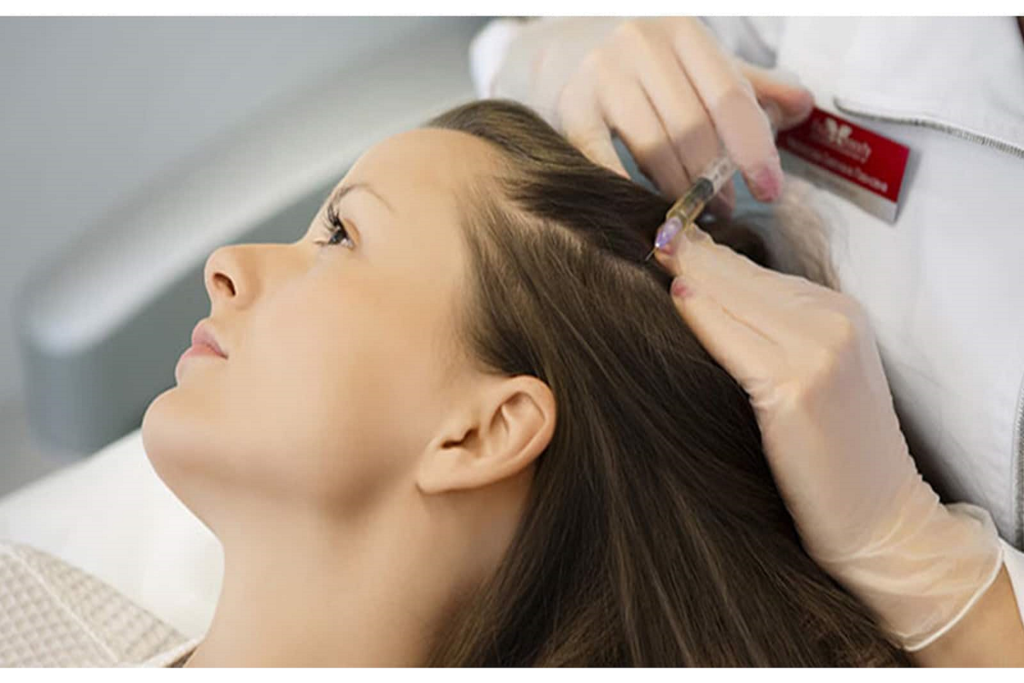
Mesotherapy for hair regrowth involves the technique of injecting nutrient-rich liquid in the mesoderm of the scalp – the layer under the epidermis which serves as a link between the layer of fats and the tissues of the skin. This is done with the help of a special mesotherapy gun that carries a sterile needle that injects the solution in the scalp. This treatment usually spans over a period of eight sessions, one every week for a duration of half an hour each. One must be patient and composed while taking this treatment as visible results are only observed after the fifth session.
The basis of the treatment substance that is injected during the therapy depends on the cause for the hair fall experienced. Since this substance generally contains vitamins, nutrients and other tissue friendly materials, this treatment is considered safe with usually no side effects or allergic reactions. The patients who undergo this treatment experience no or minimal pain and least discomfort making mesotherapy an easy solution for getting rid of the chronic problem of balding.
Another hair and scalp problem that can be treated by mesotherapy is dandruff. This alternative should, however, only be used in case of severe dandruff problems.
Mesotherapy is a technique that uses injections of vitamins, enzymes, hormones and plant extracts to rejuvenate and tighten skin, as well as remove excess fat.
Michel Pistor, a doctor in France, developed the technique in 1952. It was originally used to relieve pain. In the years since it has gained popularity in the United States and other parts of the world.
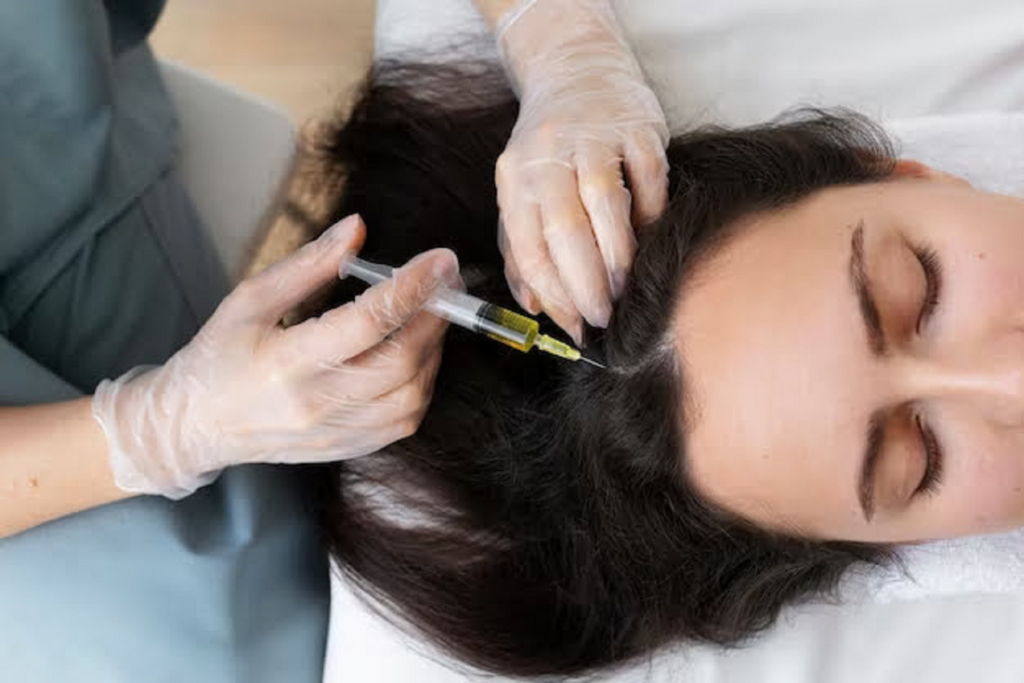
Platelet-Rich Plasma therapy for hair loss is a treatment that involves withdrawing a patient’s own blood, processing it so that only the enriched cells (platelet-rich plasma) remain and injecting it into the scalp. PRP contains essential proteins that stimulate natural hair growth. The treatment can also be combined with hair transplant surgery, microneedle, or medications.
Platelets are blood cells with several roles to play in the body. One is to promote blood clotting so that a person does not excessively bleed when they are cut. Another is to contain proteins in the blood that help wounds to heal. Researchers theorize that by injecting areas of inflammation or tissue damage with high concentrations of platelets, it can encourage wounds to heal. A small blood sample is taken from the person being treated and put into a centrifuge or other specialized device that spins at high speed. This process separates platelets from other blood components. The concentration of platelets is then injected into the area of the person’s body that needs to be treated. Because the injection contains a high concentration of platelets, which can be from 5 to 10 times more than the untreated blood, doctors theorize that the platelets will speed up healing.
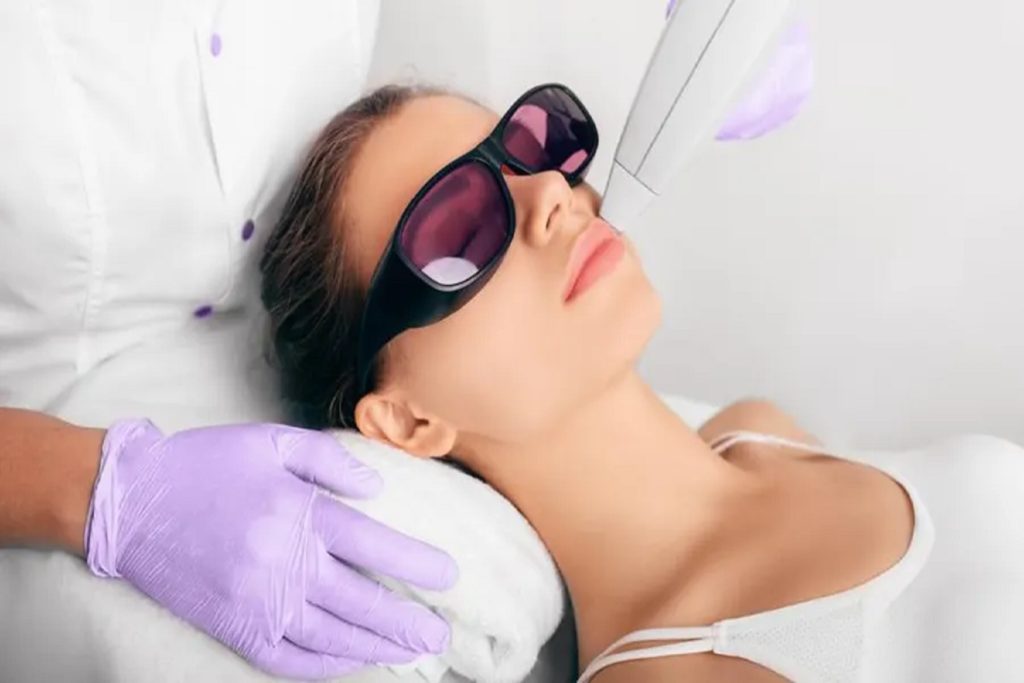
in this brief write up we’ll try and answer some of the more frequently asked questions about laser hair reduction and compare its effectiveness to the other popular forms like waxing, shaving, Intense Pulse Light (IPL) and electrolysis. A focused laser beam with the right amount of power and duration heats up the dark hair follicles and renders them useless; this technique works best for a combination of dark hair and light skin, although today there are various types of lasers that effectively cater to different skin and hair colors, for example, Ruby, Alexandrite, Pulsed diode array, Nd: YAG, etc. The Nd: YAG laser (usually pronounced n-deeyag) especially has been proven to be really effective for the darker complexions that are more common in the Indian subcontinent.
Since the laser can zap only the actively growing hair follicles (i.e. follicles in anagen), among others, at the various stages in hair growth, it usually takes about 8 to 12 sessions with a duration of 2 to 5 weeks in between each session, as advised by the cosmetologist. It may take up to 6 to 18 months for the process to complete until which it’s of paramount importance to stick to the prescribed schedule; to be able to catch as many of them growing hair follicles at their opportune times.
Many people describe the heat from the pulses of the laser as a bit unsettling at first, but nothing of the sort that one can’t handle. The numbing cream and cooling mechanism in the laser probe, i.e. either cooled air or water help mollify the skin and make the sessions more bearable.
None usually. There’s rarely any peeling, flaking or redness of the skin observed after the procedure. Although, some precautions are advised to avoid the heat for a couple of days after each session. So stay away from the gyms, shower with lukewarm (preferably cold) water, use a moisturizer and avoid the sun. If at all you have to go out in the sun, use copious amounts sunscreen that’s at least SPF 30.
Electrolysis is the process of burning out of hair follicles by passing a small electric current through their hair strand for 20 to 30 seconds. The process is effective in getting rid of hair but is extremely tedious. In comparison, lasers and IPL are almost 60 times faster and even more effectively!
Both shaving and waxing reduce body hair, but only for a short duration of time. Waxing can be an especially painful ordeal. Also lasers and IPL show results that may be deemed almost permanent.
IPL uses a very bright light (e.g. xenon lamp) just like lasers to burn out the dark colored hair follicles. The pulses of light in IPL are filtered to the appropriate color (wavelength) to make it safer for the skin. Although IPL isn’t tightly focused like a laser, it covers a wider area and can make longer duration light pulses as compared to lasers. IPLs are on par with lasers and sometimes even better in terms of the effectiveness of hair reduction. Even the side effects and their duration are lesser in IPL when compared to lasers.
So in this brief write up we explained FAQ’s about the hair reduction process and various techniques like Laser, Electrolysis and Intense Pulse Light(IPL). for further inquiry or to book appointment at Aura Cinic
***We Promise, no spam!
© 2014, Aura Clinic. All Rights Reserved.